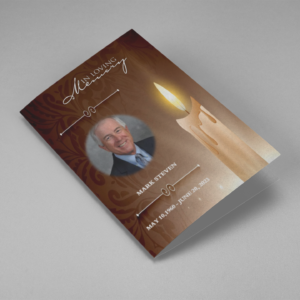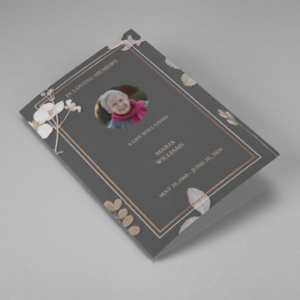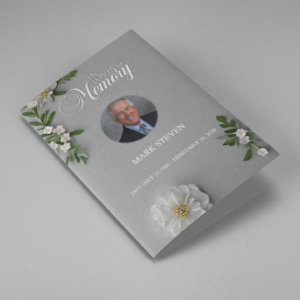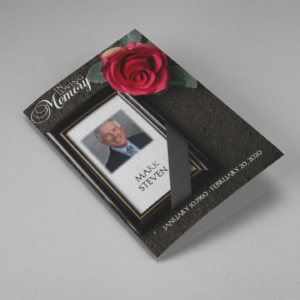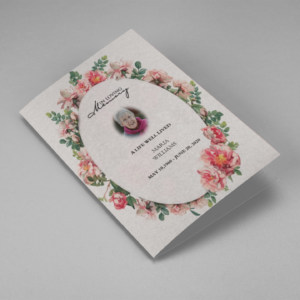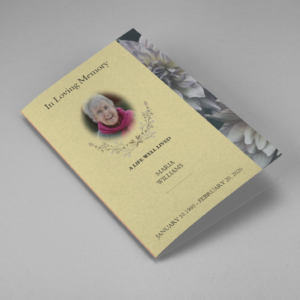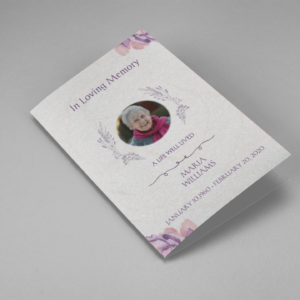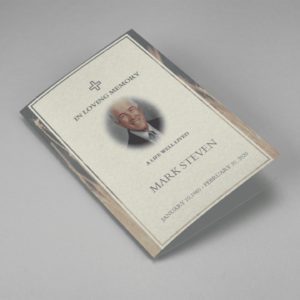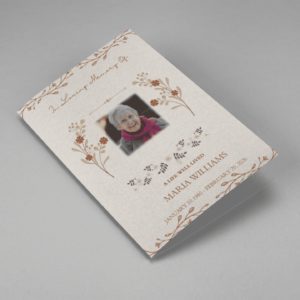Losing a loved one is one of the most difficult experiences anyone can face, and planning a memorial service to honor their life can be a daunting task. One element that helps bring a sense of order and meaning to the service is a well-designed funeral program. Not only does it provide guidance for attendees, but it also serves as a beautiful, lasting memento for friends and family to cherish.
In this post, we’ll walk you through the essentials of creating a funeral program that reflects the life of your loved one, while offering helpful tips and funeral program templates that can help make the process easier.
What Is a Funeral Program?
A funeral program is a printed document that outlines the events of a funeral or memorial service. It helps attendees follow along with the ceremony, providing key details such as the order of service, hymns, poems, and tributes. It’s not just a functional tool; it’s also a meaningful keepsake for the family and friends of the deceased.
A funeral program typically includes:
- A cover page with the deceased’s name, birth and death dates, and a photo
- The order of service for the ceremony, including prayers, songs, and readings
- Tributes, eulogies, or other personal messages that celebrate the life of the deceased
- Additional details such as acknowledgments, burial or reception information
Why Is a Funeral Program Important?
While many elements go into planning a funeral or memorial service, the funeral program holds significant value. Here’s why:
- Guides Attendees: The program ensures that everyone knows what to expect during the ceremony, helping them participate in hymns, prayers, and tributes.
- Celebrates the Life of the Deceased: It allows for personal touches, such as favorite quotes, poems, and photographs, which make the ceremony feel more intimate.
- A Keepsake for Loved Ones: A funeral program is something that friends and family can keep as a memento of the service and the person they’ve lost.
Components of a Funeral Program
When creating a funeral program, it’s essential to include the necessary components that provide structure while celebrating the life of the deceased. Here’s a breakdown of the typical sections you’ll want to include:
- Cover Page
The cover is the first thing attendees will see, so make it meaningful. Include:- The name of the deceased
- Birth and death dates
- A photograph (or photo collage)
- A quote or title that reflects their life, such as “In Loving Memory” or “Celebrating the Life of [Name]”
- Order of Service
This section outlines the flow of the service, helping guests follow along with the ceremony. Common items include:- Prelude music
- Opening remarks
- Readings (scripture, poems, or personal messages)
- Eulogies and tributes
- Hymns or songs
- Back Page
The back page often includes:- Acknowledgments: Thanking guests for attending and showing support
- Additional information: Details about the burial or reception location and time
- Personal messages or quotes that further reflect the deceased’s personality
Funeral Program Examples to Inspire You
Looking for inspiration? Here are two sample funeral program templates to help you get started:
Traditional Religious Funeral Program
- Prelude Music
- Processional
- Scripture Reading
- Prayer
- Eulogy by [Name]
- Hymn: Amazing Grace
- Closing Remarks
- Final Procession to Burial
Non-Traditional Memorial Service Program
- Welcome/Introduction
- Life Tribute (Shared by Family)
- Song or Musical Performance
- Open Mic for Guests to Share Memories
- Closing Remarks
- Post-Service Gathering Details
These examples show how flexible a funeral program can be, whether you’re planning a traditional or more modern service.
How to Design a Funeral Program
Designing a funeral program requires thoughtful consideration, but it doesn’t have to be difficult. Here are some tips to help guide you through the process:
- Choose a Paper Stock: Opt for a heavier paper (like 80 lb. text stock) or lightweight cardstock (65 lb. cover stock) for a durable, professional feel.
- Select the Right Layout: Traditional funeral programs are often 4 pages long, but single-page or multi-page designs are also popular. The layout should be easy to read and reflect the tone of the service.
- Pick a Color Scheme: Choose colors that reflect the deceased’s personality or the mood of the service. Soft pastels, earth tones, or even vibrant colors can work depending on the style of the service.
- Add Personal Touches: Incorporate meaningful photographs, quotes, or designs that capture the spirit of your loved one. Consider a collage of pictures that showcase their life journey.
Personalizing the Funeral Program
Personalization is key to making the funeral program a meaningful tribute. Here are some ways to make the program feel uniquely reflective of your loved one:
- Include a Special Quote or Poem: Whether it’s a favorite scripture or a heartfelt quote, words can express what is difficult to say in person.
- Add Photos: Including photos of your loved one at different stages of life, or in meaningful moments, can make the program even more personal.
- Design a Custom Theme: Choose a theme that reflects their interests, such as floral designs, nature motifs, or even their favorite colors.
How to Print a Funeral Program
Once you’ve finalized the design and content, it’s time to print your funeral program. Here are some options to consider:
- Funeral Home Services: Many funeral homes offer printing services, which can take the burden off your shoulders during a difficult time.
- Local Print Shops: If you want more control over the printing process, you can opt for a local printing company.
- Online Printing Services: If you prefer the convenience of online services, many websites offer custom funeral programs with templates you can personalize and have delivered directly to you.
A funeral program is an important way to honor your loved one while providing a meaningful experience for those attending the service. Whether you’re looking for inspiration, templates, or design ideas, creating a funeral program that reflects your loved one’s life and legacy can provide comfort and healing.
If you’re ready to create a heartfelt funeral program, explore our templates, tips, and design tools today. We’re here to help you create a tribute that will be cherished for years to come.



